Excel Write (SharePoint) activity
An activity that lets you create and change a Microsoft Excel file based on a Microsoft Excel template.

Configure the Excel Write activity
To configure the Excel Write activity, do the procedure in this topic.
Examples
Good to Know
- In most text fields, you can use process data variables as an alternative to literal data values.
- This activity uses only SharePoint as a data source. To use a different data source, refer to Excel Write (Document) activity.
- You can configure whether this activity waits for other activities before it runs.
For more information, refer to How Do I Configure an Activity to Wait for Other Incoming Activities?
- Some information about third-party integrations is outside the scope of the AgilePoint NX Product Documentation, and it is the responsibility of the vendors who create and maintain these technologies to provide this information. This includes specific business uses cases and examples; explanations for third-party concepts; details about the data models and input and output data formats for third-party technologies; and various types of IDs, URL patterns, connection string formats, and other technical information that is specific to the third-party technologies. For more information, refer to Where Can I Find Information and Examples for Third-Party Integrations?
How to Start
- On the Application Explorer screen, do one of these:
- Do one of these:
- Add an activity:
- In the Process Builder, go to the Activity Library, and
open the SharePoint
 tab.
tab. - On the SharePoint
 tab,
drag the Excel Write
tab,
drag the Excel Write  activity onto your process.
activity onto your process.
- In the Process Builder, go to the Activity Library, and
open the SharePoint
- Change an activity:
- In your process, double-click your activity.
- Add an activity:
Procedure
- Complete the fields on the
General Configuration screen.
For more information, refer to Configure General Options for a System Activity.
- Click Design Time Repository
 .
. - On the Design Time Repository screen, click SharePoint as the data source for your design time template.
- Click Design Time Repository Configuration
 .
. - Complete the fields on the Design Time Template Configuration screen.
- Click Run Time Repository
 .
. - On the Runtime Repository screen, click SharePoint as the data source for your runtime template.
- Click Run Time Repository Configuration
 .
. - Complete the fields on the Runtime Template Configuration screen.
- Click Save To Repository
 .
. - On the Save To Repository Configuration screen, click SharePoint as the target data source to save your file.
- Click Write Excel Document Configuration
 .
. - Complete the fields on the
Write Excel Document Configuration screen.
For more information, refer to Create an Excel File in SharePoint
- (Optional) Click Advanced
 >
E-mail Notifications
>
E-mail Notifications  .
.
For more information, refer to Configure E-mail Notifications for Any Activity.
General Configuration
Specifies the basic settings for the Excel Write activity.
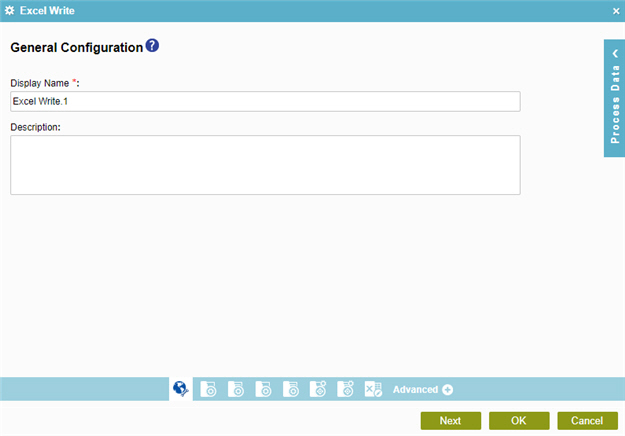
Fields
| Field Name | Definition |
|---|---|
|
Display Name |
|
|
Description |
|
Design Time Repository
Specifies SharePoint as the data source for your design time template.
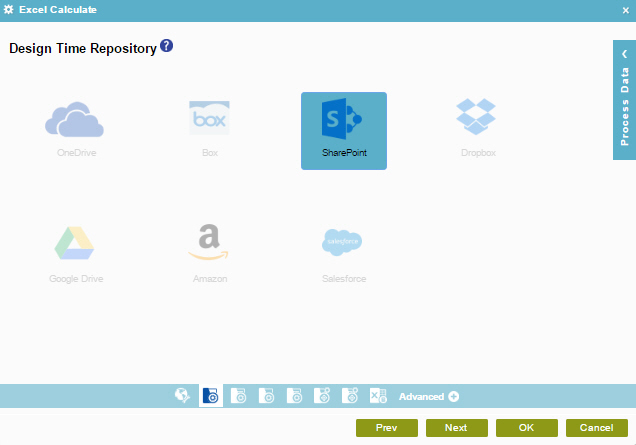
Fields
| Field Name | Definition |
|---|---|
|
SharePoint |
|
Design Time Template Configuration
Specifies the data source for your design time template in SharePoint.
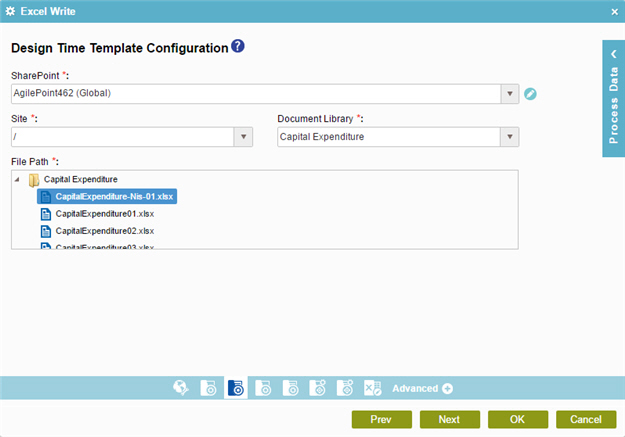
Fields
| Field Name | Definition |
|---|---|
|
SharePoint |
|
|
Add Token |
|
|
Site |
|
|
Document Library |
|
|
File Path |
|
Runtime Repository
Specifies SharePoint as the data source for your runtime template.
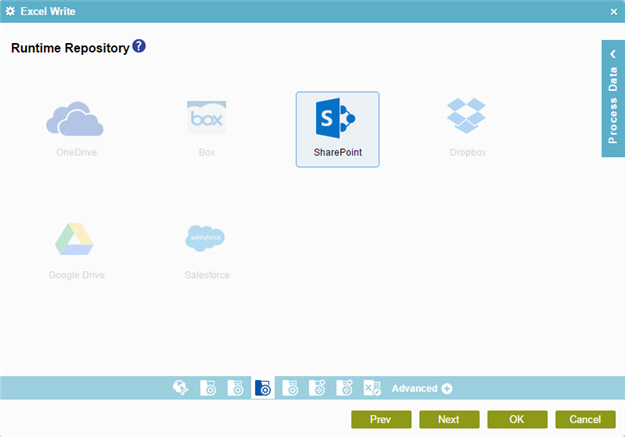
Fields
| Field Name | Definition |
|---|---|
|
SharePoint |
|
Runtime Template Configuration
Specifies the data source for your runtime template in SharePoint.
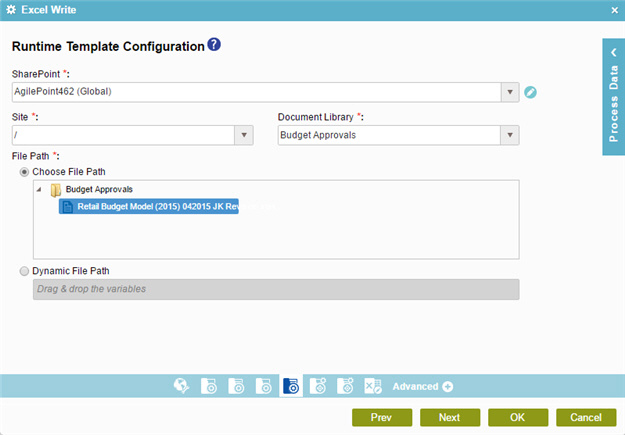
Fields
| Field Name | Definition |
|---|---|
|
SharePoint |
|
|
Add Token |
|
|
Site |
|
|
Document Library |
|
|
File Path |
|
Save To Repository
Selects the target storage repository as SharePoint for your files.

Fields
| Field Name | Definition |
|---|---|
|
SharePoint |
|
Save To Repository Configuration
Specifies the target location for your Microsoft Excel document on SharePoint.
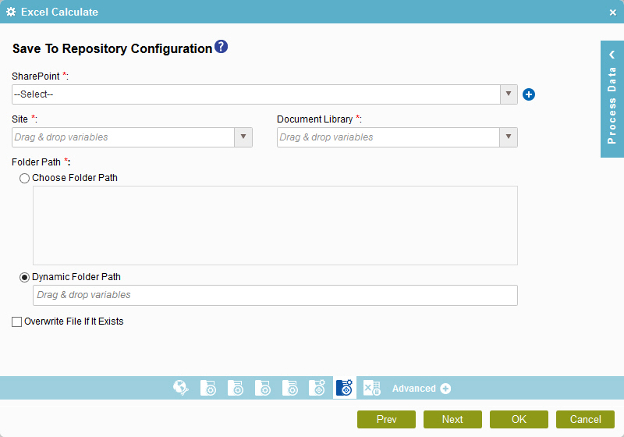
Fields
| Field Name | Definition |
|---|---|
|
SharePoint |
|
|
Add Token |
|
|
Site |
|
|
Document Library |
|
|
Folder Path |
|
|
Overwrite If File Exists |
|
Write Excel Document Configuration
Configures an operation to create a Microsoft Excel file.

Fields
| Field Name | Definition |
|---|---|
|
SharePoint |
|
|
Add Token |
|
|
Excel Services URL |
|
|
Runtime Template |
|
|
Design Time Template |
|
|
Save To |
|
|
Click to Load Excel Fields |
|
|
Excel Field |
|
|
Process Value |
|
|
Move All |
|


